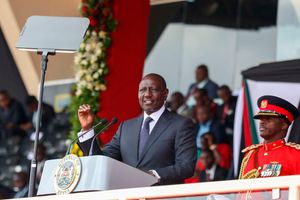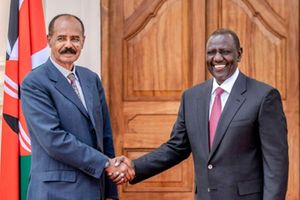Premium
EU injects Sh700m to address climate change, drought in Baringo

EU ambassador Myra Bernadi (in blue cap) with Self Help Africa officials during a tour to one of the demonstration farms in Sandai, Baringo South.
For many years, Baringo County has suffered the effects of climate change, ranging from floods to droughts that have contributed to food scarcity, forcing locals to rely on food aid.
But residents can now breathe a sigh of relief after the European Union (EU) pumped 5.6 million euros (Sh700 million) into a five-year programme aimed at building resilience in agricultural activities by increasing production and diversification.
The programme will be implemented by Self Help Africa (SHA), an international charity working with small-scale farmers in nine counties.
The programme, being rolled out in Baringo North, Baringo South, Mogotio and Tiaty sub-counties, seeks to benefit more than 60,000 locals. They will be helped to increase crop and livestock production, improve land management practices, increase disposable income and reduce stunted growth among children.
Among the targets are 10,000 households, 400 farmer producer groups, 100 mother-to-mother support groups and 1,500 school children.
SHA head of programmes Edgar Kadenge said they help farmers acquire the necessary skills to ensure greater production of both crops and livestock. They also support measures that can improve livelihoods where food production has been affected by climate change in arid and semi-arid areas.
“When you want to build the respective value chains, the starting point is the methods and systems being used for its production, by moving from traditional and adopting modern methods,” Mr Kadenge said.
He also said they work with targeted farmers to ensure that they produce the right type of crop, for instance, adopting drought-tolerant varieties of sorghum, green grams and millet.
The initiative also ensures that farmers are cognisant of nutrition needs, by training women to adopt nutrition-sensitive farming practices and how well they are utilising the crops produced and others.
The programme, a partnership with the National Disaster Management Authority (NDMA), the county government and Farming Systems Kenya, also seeks to ensure farmers get more income to improve their standards of living.
“We are in close contact with farmers right from preparation of land, planting, harvesting and post-harvesting to ensure that they get access to markets for their produce, for instance, supporting off-take programmes like the annual Kimalel goat auction,” Mr Kadenge said.
The five-year programme also involves the rehabilitation of more than 20,000 hectares of degraded land in a bid to solve perennial inter-community conflicts over limited resources like water and pasture.
Invasive plants
“Through the initiative, we plant trees to restore existing water sources and plant fodder, which we are targeting to restore more than 20,000 hectares of grazing areas, an initiative that will mitigate against the perennial conflicts among pastoralist communities,” he explained.
Among other initiatives the organisation is undertaking is putting invasive plants, including mathenge and cactus, to economic use.
“The best thing is to find economic utilisation of (mathenge) to let it bring income and its presence will continue to preserve the environment,” said Calvin Okungu, programmes manager of a climate change group Baringo Resilience.
EU ambassador Myra Bernadi, in charge of agriculture, job creation and resilience, on a tour of the area last week, said arid and semi-arid regions have over the years remained at great risk of losses resulting from hazards such as extreme droughts and floods.
“While droughts may be an unavoidable natural phenomenon in the Horn of Africa, their impact can be mitigated by human action. Droughts should not lead to famine and other disasters,” said Ms Bernadi.
The project will adopt a range of climate-smart approaches to develop strategies for achieving food and nutrition security and reduce poverty.
Climate change led to rising water levels last year in lakes Bogoria and Baringo, displacing more than 10,000 people.
The size of Lake Baringo, for instance, had increased from 236km square in 2015 to about 278km square, posing a threat to adjacent structures including homesteads and institutions.
Lake Bogoria had also increased from the 34km square to about 45km square within one month, submerging major roads leading to the park and adjacent structures.
Locals said many families who used to practise large-scale farming in the flooded villages now go without food for days and many children suffer from malnutrition because they lack balanced meals.
Perkerra Irrigation Scheme Manager Enos Wafula said farmers lost over Sh21 million after more than 52 acres under seed maize in the scheme was swallowed up by the flooding, with Loropil and R14TV blocks hit hardest.
He noted that farmers face starvation as crops were washed away downstream by the floods.
“Most farmers who were growing seed maize do not have income as most of their farms were submerged by rising water levels in Lake Baringo last year.,” Mr Wafula said.
“The situation was aggravated this year as some farmers also lost their crops owing to the long dry spell that led to River Perkerra, which is the main source of water, almost drying up.”
Every year between April to September, he said, more than 2,500 acres is put under seed maize production but the acreage dropped to 2,304 acres due to acute water shortages caused by the long dry spell.
The irrigation scheme depends on the Perkerra, the only permanent river in the sub-county that almost dried up this year due to drought.
Last year, the entire scheme was under crops and farmers earned a gross income of Sh330 million. This year, the earnings are expected to drop to Sh290 million because of the effects of climate change.





